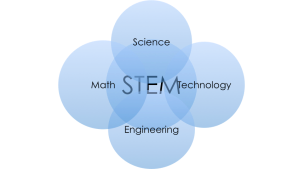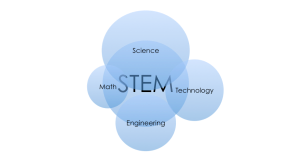Perspective on STEM Education
There are so many different perspectives on STEM education. These perspectives can vary depending on job title, location and teaching style. These many perspectives can make it confusing for teachers trying to implement STEM centric lessons into their classroom. What exactly is a “STEM” lesson?
In Chapter 8 of The Case for STEM Education the author, Rodger W. Bybee, goes through many different perspectives of STEM. Bybee bases these perspectives on discussions, articles, reports, and projects to help clarify what STEM education is. As I read through Chapter 8 I found it easier to look at the graphics Bybee provided and determine which ones I didn’t think represented STEM education. Many graphics displayed the four STEM disciplines as separate topics and not integrated. My perspective of STEM education is an integrated version where all four disciplines are taught together. Below is what my perspective of STEM education would look like.
I think in order for a lesson to be considered a “STEM lesson” it needs to incorporate all four disciplines. In my graphic I show the four disciplines merging together to form “STEM”. Many of the graphics in Bybee’s chapter showed all four disciplines, but did not show them integrated. Instead, the four disciplines were taught separately or two disciplines were taught separately, but became connected through the technology OR engineering discipline. Currently (this may change throughout the program), I think that if we want to start calling our lessons “STEM” lessons then they need to include all four disciplines integrated together.
I couldn’t figure out how to show this in my graphic, but I wanted the four disciplines to show movement in size depending on the lesson being taught. I don’t think all four disciplines should be equally dispersed in a lesson for it to be considered STEM. Some lessons lend themselves easier to incorporate some of the disciplines than others. For example, I think incorporating the math discipline can be extremely hard for some lesson topics. I know from planning my own STEM kindergarten lesson that the math discipline was difficult to incorporate. Also, after talking to my peers on our graphics created to represent STEM, I found they felt the same way about the math discipline. Not only did most people feel it was hard to create a lesson that included ALL four disciplines, but it was especially hard to include the math discipline. If I could recreate my graphic to show my STEM lesson this is what it would look like:
As you can see, the four disciplines are not dispersed evenly throughout the lesson. In my STEM lesson I had students try and solve the deer overpopulation problem in their neighborhood. We looked at a forest ecosystem and talked about the important components to keep that ecosystem alive and what could damage it. We also talked about how deer can not only harm the ecosystem but how they can also be very harmful to humans. Their job was to come up with a solution to solve the deer overpopulation problem. I used math in my lesson by making a tally graph to represent data on a question I asked my students. If I used this lesson with upper grade students I can see incorporating math by talking about the specific population numbers compared to other animal, plant or humans population numbers in that ecosystem. My math discipline was the smallest circle in this particular lesson with my students, but maybe for the next STEM lesson I plan the technology circle will be smaller. Like I stated earlier, I think some lesson lend themselves better to incorporating certain disciplines more than others.
My perspective on STEM education has changed so much throughout the course of the two classes I’ve taken so far. Even through hearing my peer’s perspectives on STEM education has caused me to re-think what STEM education looks like in the classroom. With this, my definition of STEM has also changed. I know my perspective and definition of STEM will continue to change throughout the course of this program.
Now that I’ve officially finished my first year in this program I’ve been asked to revisit my perspective on STEM. I remember the first time I was asked to think about what STEM education looks like in a classroom I wasn’t really sure what I thought. This was my main question, and continues to be a question, as I think about what a STEM lesson looks like. How much math, science, technology or engineering needs to be in a STEM lesson for it to be considered “STEM”? At first I thought all four disciplines needed to be included in a lesson to be considered STEM and those disciplines needed to be very noticeable. For example, I thought you should be able to easily pick out what part of the lesson are math, science, engineering and technology. You can imagine planning a lesson like this would be very difficult and overwhelming.
I see the concern and worry other teachers might have when it comes to implementing STEM lessons. They do in fact take a lot of time to plan and implement correctly. I think of STEM lessons more like projects because they can sometimes take weeks to finish. You never know the length of the project because it depends on how your students respond so it’s hard to gage an ending point. They can also be a little scary to implement because I don’t think you can ever been 100% sure where the lesson will go. As the classroom teacher you can sometimes predict what kinds of questions your students will ask and where their discussions will go but there is some uncertainty.
After taking engineering this semester my perspective on what STEM looks like in the classroom has changed. Towards the end of the class we talked about the different disciplines in regards to engineering and if you could have an engineering lesson without it being considered STEM or if you could have a STEM lesson without engineering. At first I thought sure you could have an engineering lesson without the other disciplines. I thought about a scenario our teacher gave us about redesigning a grocery store during the class. I tried to pick out the different disciplines and I couldn’t so I thought that would be an example of an engineering lesson. As I listened to the group discussion I soon realized that although the 3 other disciplines weren’t immediately clear they were in fact integrated in the lesson. I learned that through this course your STEM disciplines aren’t always apparent looking at the surface until you dig deeper into the lesson.
Although I’ve been in this program for a year I still get a little overwhelmed and panicked when I think about planning STEM lessons. I see the value and importance of preparing our students for jobs of the future but if you don’t know the research behind STEM in the classroom it’s more difficult to implement.
References
Bybee, R. W. (2013). The Case for STEM Education: Challenges and Opportunities. Arlington, VA: National Science Teachers Association.

